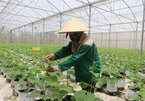 |
| On average, Vietnamese consume 134 grams of meat per day, and 154 grams of meat per day for people in urban areas. |
After 10 years implementing the National Strategy on Nutrition for the 2011-2020 period, Vietnam has reported remarkable achievements but there are still many problems that need to be overcome, including nutrition.
On average, Vietnamese consume 134 grams of meat per day, and 154 grams of meat per day for people in urban areas. Meanwhile, the recommended nutritional intake of meat is 50 - 80 grams per day. The World Cancer Prevention Organization recommends that a person should not consume more than 70 grams of meat per day.
The information was shared by Dr. Truong Tuyet Mai, Deputy Director of the National Institute of Nutrition, at a recent workshop.
While meat consumption is in excess of the recommended amount, consumption of fruits and vegetables has not increased significantly. In 2010, a Vietnamese consumed 190 grams of vegetables per day and 60.9 grams of fruit per day on average. The figures have increased to 230 grams of vegetables and 127 grams of fruit per day. However, only 65 percent of Vietnamese people meet the recommended consumption of fruit and vegetable.
According to Prof. Le Danh Tuyen, Director of the National Institute of Nutrition, after 10 years implementing the National Strategy on Nutrition for the period 2011-2020, Vietnam has recorded remarkable achievements.
For the first time, the rate of children under 5 years old with stunting due to malnutrition fell to below 20% (from 29.3% in 2010 to 19.6% in 2020). The proportion of under-5 undernourished children decreased from 7.1% in 2010 to 5.2% in 2019.
The height of Vietnamese people has increased significantly. In 2020, the average height of men reached 168.1cm (an increase of 3.7cm compared to 2010 - 164.4cm) and of women 155.6cm (an increase of 0.8cm compared to 2010 - 154, 8cm).
“This is a big leap, showing the efforts in nutrition improvement in Vietnam. Nutrition is the most important external factor in height development,” said Professor Tuyen.
 |
|
Prof. Le Danh Tuyen, Director of the National Institute of Nutrition.
|
However, malnutrition is still a problem in some mountainous provinces, Prof. Tuyen said. The rate of under-5 children with stunting in some provinces is still high (Ha Giang 31.7%, Cao Bang 30.4%, Kon Tum 33.4%, Gia Lai 32%).
Micronutrient deficiencies and obesity is also a concern. In 2010, the rate of overweight and obese children under 5 years old was 5.6% and 8.5% for people from 5-19 years old. The current rates are 7.4% and 19 %, respectively. This situation is most serious in big cities such as Hanoi, Ho Chi Minh City, Hai Phong, and Da Nang.
The increase of non-communicable diseases among Vietnamese such as diabetes, cancer and stroke are the result of an inappropriate diet, Tuyen said.
Experts of the Health Ministry are working on the National Nutrition Strategy for the new period.
Nguyen Lien

Science to be used to ensure food security, nutritional balance
A new Government resolution aims to use science and technology to ensure nutritional balance in the Vietnamese diet.